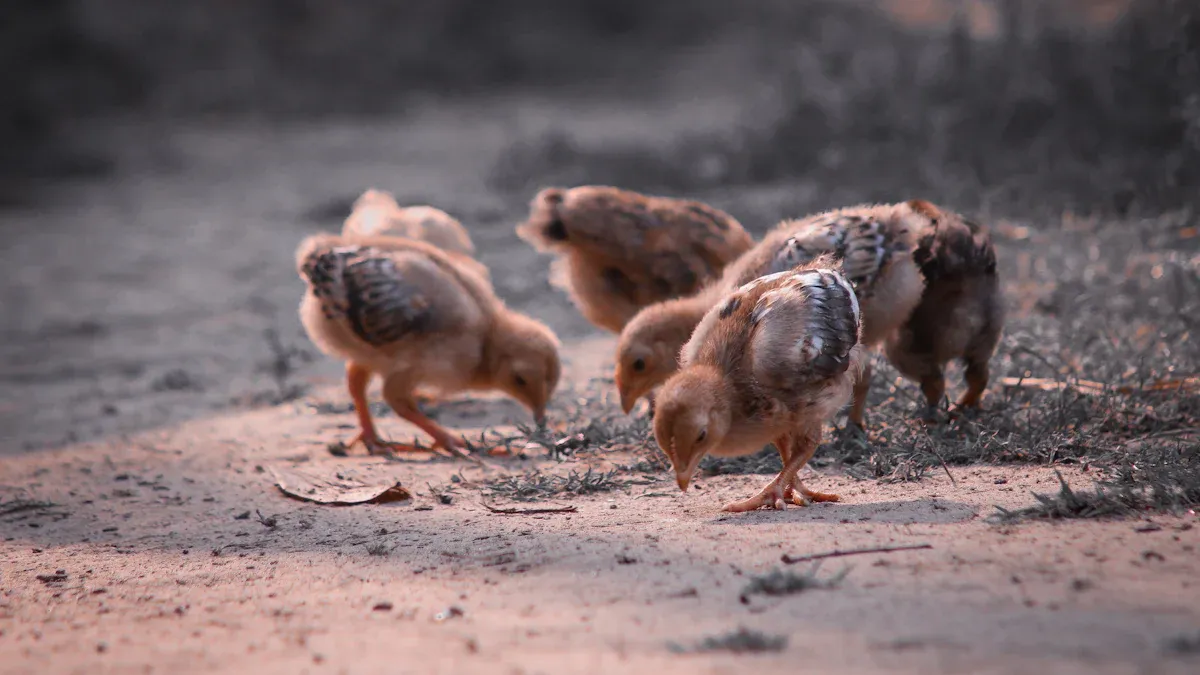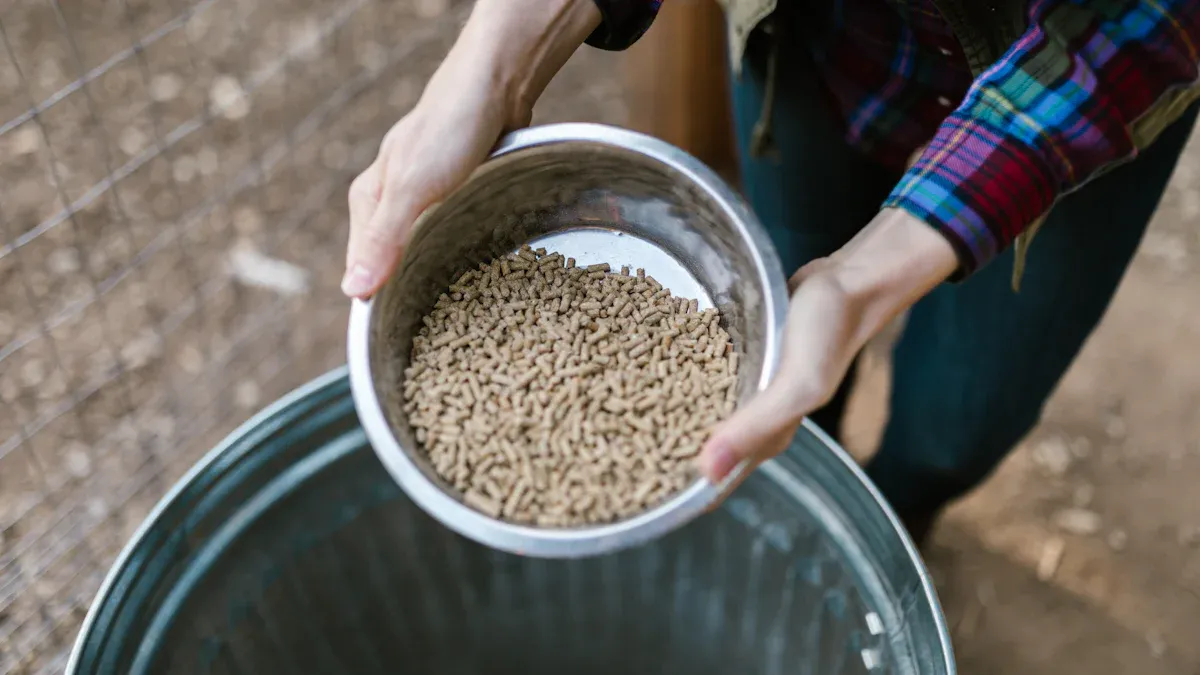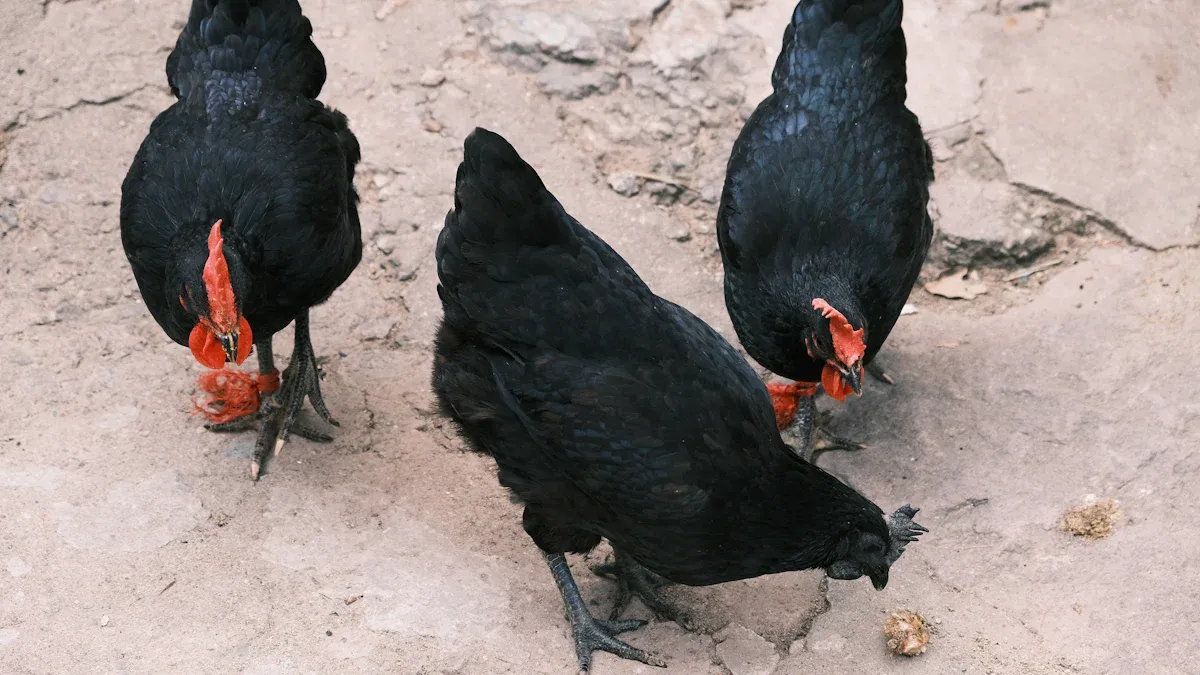
Feeding dried mealworms for poultry farms is simple and rewarding. These tiny powerhouses are packed with protein, fats, and essential nutrients that boost growth and egg production. Studies show that replacing soybean meal with dried mealworms improves weight gain and nutrient digestion in chickens. For poultry farms, dried mealworms offer a convenient way to enhance health and productivity without extra effort.
Key Takeaways
- Dried mealworms have lots of protein. They help birds grow and lay more eggs. Add them to diets for stronger, healthier birds.
- Give mealworms to your birds slowly. Start with little amounts so they get used to them. This also helps birds learn to search for food naturally.
- Mix mealworms with normal feed. Use them as snacks and keep portions small. This stops overfeeding and keeps their diet healthy.
Benefits of Dried Mealworms for Poultry Farms

High Protein for Growth and Egg Production
Protein is essential for poultry growth and egg production, and dried mealworms are an excellent source. Compared to traditional feed sources, mealworms provide higher protein content, which supports muscle development and improves egg quality.
| Feed Type | Protein Content (g/100g) | Other Nutritional Aspects |
|---|---|---|
| Control Feed (Agar) | Baseline | Lower dry matter content |
| Vegetable Mix | Higher | Increased crude ash, fat, and protein content |
| Potato Cuttings | Significant increase | Doubled fat content, decreased protein and chitin |
| Horticultural Foliage | Similar | No significant change in mealworm biomass |
Studies show that increasing mealworms in broiler diets leads to better weight gain and nutrient absorption. For instance:
- Adding 50-150 g/kg of mealworms to broiler diets resulted in a linear increase in body weight and daily weight gain.
- Replacing 15% of soybean meal with mealworms improved carcass percentage and breast weight.
These benefits make dried mealworms for poultry farms a smart choice for boosting productivity.
Natural Nutrients for Health and Molting
Dried mealworms are packed with nutrients like fats, amino acids, and minerals. These nutrients are vital for poultry health, especially during molting when birds need extra support for feather regrowth. The chitin in mealworms also promotes gut health by reducing harmful bacteria and encouraging beneficial gut flora. This helps improve digestion, feather development, and egg production.
Farmers often notice healthier, more active birds when mealworms are part of their diet. The natural nutrients in mealworms make them a valuable addition to any poultry farm.
Encouraging Foraging and Enrichment
Chickens love to scratch and peck, and dried mealworms encourage this natural behavior. Tossing mealworms into the coop or yard stimulates foraging, which keeps birds mentally and physically active. This activity reduces stress and promotes overall well-being.
Foraging also helps prevent boredom, which can lead to unhealthy habits like feather pecking. By incorporating dried mealworms for poultry farms, farmers can create a more enriching environment for their birds.
Preparing and Feeding Dried Mealworms

Selecting Quality Dried Mealworms
Choosing the right dried mealworms is essential for poultry health. High-quality mealworms should be free from additives, preservatives, or artificial coloring. Look for products that are 100% natural and have been processed under hygienic conditions. This ensures the mealworms retain their rich protein, essential fats, and nutrients, which are crucial for poultry growth and feather development.
Farmers should also check the packaging for proper labeling, including nutritional information and expiration dates. Buying from reputable suppliers reduces the risk of contamination and ensures the mealworms meet safety standards. By selecting premium dried mealworms, poultry farms can provide their birds with a nutritious and safe treat.
Soaking vs. Feeding Dry Mealworms
Dried mealworms can be fed as-is or soaked in water before serving. Feeding them dry is convenient and mess-free, making it a popular choice for many farmers. However, soaking mealworms in water for 10-15 minutes can make them easier to digest, especially for younger or smaller birds. Soaked mealworms also provide extra hydration, which is beneficial during hot weather.
Both methods offer nutritional benefits, so farmers can choose based on their flock’s needs. For instance, dry mealworms are ideal for quick treats, while soaked ones work well as part of a balanced meal. Experimenting with both options helps determine what works best for the birds.
Introducing Mealworms to Poultry
Introducing dried mealworms to poultry diets should be done gradually. Start by offering a small handful as a treat and observe the birds’ reaction. Most chickens will eagerly peck at the mealworms, but some may take time to adjust. Scatter the mealworms in the yard or coop to encourage natural foraging behavior.
Younger birds may need more time to recognize mealworms as food. Mixing a few mealworms with their regular feed can help them get accustomed to the new addition. Over time, poultry will associate mealworms with a tasty and nutritious reward. This gradual approach ensures a smooth transition and minimizes any potential digestive issues.
Feeding Quantities and Safety Precautions
Recommended Daily Amounts
Feeding dried mealworms to poultry requires careful portioning to avoid overfeeding. Chickens benefit from mealworms as a protein-rich supplement, but moderation is key. For adult chickens, offering 10-15 grams of dried mealworms per bird daily is a good starting point. Younger birds may need smaller amounts, around 5 grams per day.
Mealworms also contribute to bone health. Studies show that mealworms raised on calcium-rich substrates improve bone density in chickens. A diet containing 35% calcium carbonate in mealworms achieves an ideal calcium-to-phosphorus ratio within 72 hours. This makes mealworms a valuable addition for supporting skeletal development.
Balancing Treats with Regular Feed
Mealworms are a treat, not a replacement for regular feed. Combining dried mealworms with standard poultry feed ensures birds receive a balanced diet. Research highlights that substituting 15% of soybean meal with mealworms enhances growth and carcass traits in broiler chickens. This combination boosts productivity while maintaining nutritional balance.
Farmers should mix mealworms with regular feed or scatter them as treats. This approach prevents over-reliance on mealworms and ensures birds consume their staple diet. A balanced feeding strategy keeps poultry healthy and productive.
Identifying and Managing Risks
Feeding dried mealworms comes with potential risks, but proper precautions minimize them. Microbial contamination is a concern, with microorganisms like Spiroplasma and Erwinia species identified in mealworms. Buying from reputable suppliers and ensuring hygienic processing reduces this risk.
Farmers should also monitor their birds for digestive issues when introducing mealworms. Gradual feeding adjustments help poultry adapt to the new diet. Additionally, the lack of clear regulations in some regions, such as South Africa, may cause hesitance among farmers. Staying informed about local guidelines ensures safe and responsible feeding practices.
Incorporating dried mealworms into poultry diets offers numerous benefits. They boost growth, improve digestion, and even enhance meat quality. Proper preparation ensures safety and maximizes nutritional value.
🐔 Did you know?
Educated farmers are leading the way in adopting mealworms, recognizing their potential as a sustainable protein source.
Start today and watch your flock thrive!
제품 정보
How often should dried mealworms be fed to poultry?
Farmers can feed mealworms daily as a treat. Limit portions to 10-15 grams per adult chicken to avoid overfeeding.
🐔 팁: Adjust quantities based on bird size and age.
Can dried mealworms replace regular poultry feed?
No, mealworms are a supplement, not a replacement. Combine them with standard feed to ensure a balanced diet for optimal health and productivity.
Are dried mealworms safe for all poultry breeds?
Yes, mealworms suit all breeds. However, introduce them gradually to avoid digestive issues and monitor birds for any unusual reactions.
✅ 참고 : Always choose high-quality, additive-free mealworms.


